Solar energy technology has improved over the years. New and improved designs produce higher efficiency, greater performance and have a better appearance.
Recently, scientists have explored ways to improve the efficiency of solar-thermal by making use of Fresnel lenses or parabolic reflectors for concentrated solar thermal power generation. However, for initiating this reaction, solar energy equivalent to 1,000 times that of an average sunny day is required.
MIT mechanical engineer, Hadi Ghasemi has developed a new cheap material that converts sunlight into steam at a solar intensity about 10 times that of a sunny day…the lowest optical concentration reported so far.
New material structure is made from relatively inexpensive materials and it converts sunlight into steam at an amazing 85% efficiency. It consists of a thin double layered disc. The top layer is active layer and it consists of graphite flakes. The bottom layer is spongy carbon foam.
How it works:
When sunlight hits the structure’s surface, hot spots are created in graphite. These hot spots draw water up through the material’s pores via capillary action. When the water reaches the hot spots in the graphite, there’s enough heat to turn the water into steam.
As this steam-generating application can function with lower concentrations of sunlight, the setup would not require complex and costly systems to highly concentrate the sunlight.
It’s a great concept but the technology is still at a very early stage. There is still a lot of research which needs be done to implement this in larger systems.






